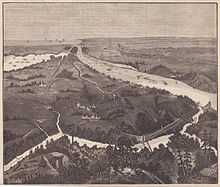New Croton aqueduct

The New Croton aqueduct, built roughly parallel to the Old Croton aqueduct was constructed to provide a large steady water supply for New York City. The aqueduct opened on July 15, 1890.[1] It runs from the New Croton reservoir in Westchester County to the Jerome Park Reservoir in The Bronx, from which it distributes water to certain areas of the Bronx and Manhattan before emptying into Tunnel 1 of the Catskill/Delaware System.
Due to numerous water quality issues, a filtration plant, the Croton filter plant, is being constructed within Van Cortlandt Park to improve water quality. Because of these quality problems, the Croton system is often bypassed or mixed with water from the Catskill Aqueduct and/or Delaware Aqueduct. The project is over budget and behind schedule.[2]
The Croton system is one of three systems that provide water to New York City. The Catskill and Delaware systems are the other two.[3]
References
- ↑ "The New Aqueduct Opened; Water Flowing at One-Third the Reservoir's Capacity". The New York Times. July 16, 1890. Retrieved 2011-03-17.
- ↑ Gonzalez, Juan (25 Jun 2013). "Ten years later, Croton Water Filtration Plant deal to invest in parks, playgrounds a mess of broken promises". NYdailynews.com. Retrieved 1 Dec 2014.
- ↑ "The Croton Water Filtration Plant Project". NYC.gov. Retrieved 1 Dec 2014.
See Also
| ||||||||||||||||||||||||||||||||||
Coordinates: 41°05′25″N 73°50′35″W / 41.09028°N 73.84306°W